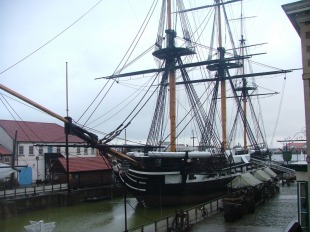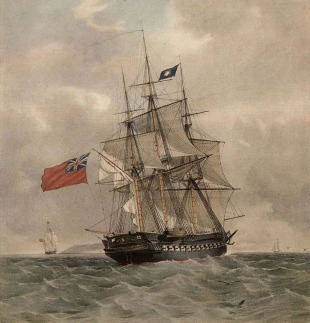Вітрильні фрегати класу «Леда»
Основна інформація
Головні розміри
Машина
Sails
Персонал
Бойові сили та засоби
- Upper deck: 28 * 18-pounder guns
- Forecastle: 2 * 9-pounder guns + 2 * 32-pounder carronades
- Quarterdeck: 8 * 9-pounder guns + 6 * 32-pounder carronades
The Leda-class frigates, were a successful class of forty-seven British Royal Navy 38-gun sailing frigates constructed from 1805-1832. Based on a French design, the class came in five major groups, all with minor differences in their design. During their careers, they fought in the Napoleonic Wars and the War of 1812. Forty-five of the 47 were eventually scrapped; two still exist.
The design of the name ship, Leda of 1800, was based on Sané's design for the French Hébé-class frigate. The British 44-gun fifth rate HMS Rainbow captured Hébé in 1782. (The British took Hébé into service as HMS Hebe but in 1805 renamed her HMS Blonde). The class of frigates built to the lines of Leda were in contemporary parlance called the 'Repeat Leda class'.
Pomone and Shannon, the second and third ship of the class respectively, was built using Josiah Brindley's patent method of construction which dispensed with 'lodging' and 'hanging knees', oak elements which had to be grown to shape. Oak suitable for shipbuilding had become increasingly difficult to obtain through the long period of warfare. Bindleys fastenings proved to be weak. Captain Philip Broke of the Shannon claimed her topsides were weak and «worked like a basket.» Shannon was actually is such poor condition by 1813 that she almost missed her engagement with the USSChesapeake.
The vessels of the class were fast, most recording 13 knots (24 km/h; 15 mph) large and 10 knots (19 km/h; 12 mph) close-hauled. However, their French-style proportions made them unweatherly compared to frigates designed to British proportions (such as the Lively class). Many captains requested additions to the frigates' false keels to remedy this. The Leda class stood to their canvas well and liked a stiff gale, but were prone to excessive pitching in very heavy seas. All captains complained of the class's poor stowage capacity, the result of their fine French underwater lines, but stowage improved after the introduction of iron fresh-water tanks. Lastly, captains considered the class to be «wet», a result of lively rolling and pitching causing seams to loosen.
- Коментарі
 uk
uk en
en ru
ru


 Королівські військово-морські сили Великої Британії
Королівські військово-морські сили Великої Британії